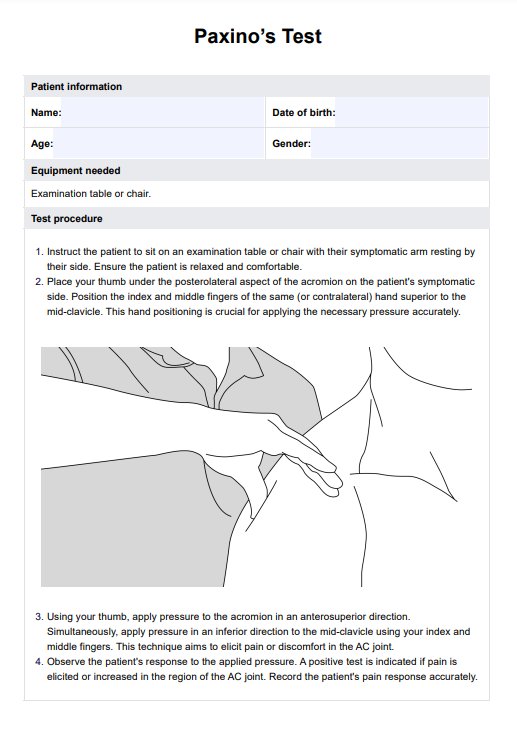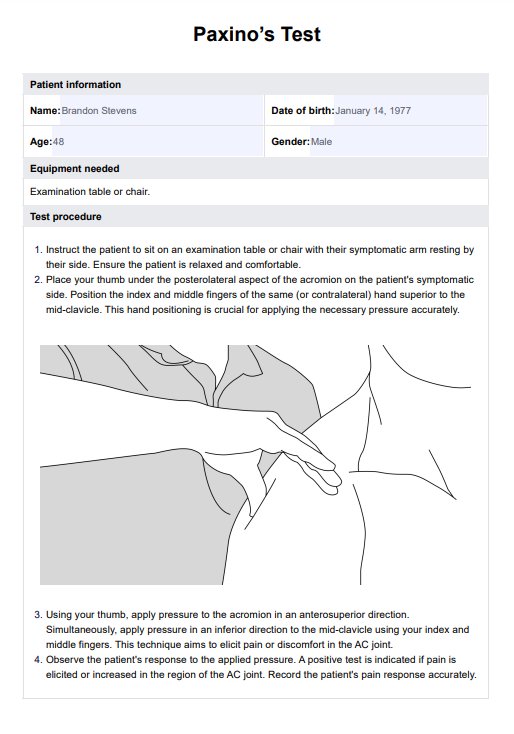Paxinos Test
Learn how to conduct the Paxinos Test, an assessment that can aid in diagnosing acromioclavicular joint pain.


What is the Paxinos Test?
The Paxinos Test is one of the tests for acromioclavicular joint pathology assessment, specifically to check if there's a dislocation or separation of the joint. It is performed with the patient seated, ensuring the symptomatic affected arm is relaxed by their side. The examiner stands beside the patient and places their thumb under the posterolateral aspect of the affected arm at the acromion while positioning the index and middle fingers superior to the mid-clavicle.
The examiner then applies pressure in two directions: anterosuperior pressure to the acromion with the thumb and inferior pressure to the mid-clavicle with the index and middle fingers. This dual-pressure maneuver aims to provoke pain or discomfort in the acromioclavicular joint.
Lastly, the examiner monitors the patient's response throughout the test to determine the presence of pain, specifically in the AC joint region.
Paxinos Test Template
Paxinos Test Example
How to use our Paxinos Test template
The Paxinos Test template is designed to help healthcare professionals accurately diagnose acromioclavicular joint pain. Follow these steps to use the template effectively
Step 1: Grab a copy of the template
Click the "Use template" or "Download" button to obtain a copy of the Paxino's test so you have a clear and structured approach to performing and documenting the test, ensuring consistency and reliability in the results.
Step 3: Prepare the patient
Begin by instructing the patient to sit comfortably on an examination table or chair with their symptomatic arm resting by their side. Make sure the patient is relaxed and understands the procedure. Explain the test to gain cooperation and ensure they know what to expect.
Step 3: Position the examiner's hands
Place your thumb under the posterolateral aspect of the acromion on the patient's symptomatic side. Then, position your index and middle fingers of the same (or contralateral) hand superior to the mid-clavicle. This setup is crucial for applying the necessary pressure to elicit a response.
Step 4: Apply pressure
Apply pressure to the acromion in an anterosuperior direction using your thumb. Simultaneously, apply pressure in an inferior direction to the acromion, index, and mid-clavicle with your index and middle fingers. This maneuver is aimed at provoking any pain or discomfort from the acromioclavicular joint.
Step 5: Monitor the patient's response
Observe the patient's reaction to the applied pressure. A positive test is indicated by pain elicited or increased in the AC joint region. Record the patient's pain response accurately in the results section of the template.
Step 6: Document the results
Use the template to document whether the test results are positive or negative. A positive test result suggests potential inflammation or irritation of the AC joint, while a negative result indicates no significant issues with the AC joint. Ensure all findings and observations are noted clearly.
How are the results interpreted?
The results of the Paxinos Test are interpreted based on the patient's pain response. A positive result is indicated if the patient experiences pain or increased discomfort in the region of the acromioclavicular joint when pressure is applied. This suggests that the pain may originate from the AC joint, possibly due to inflammation, arthritis, or other AC joint pathology.
Conversely, a negative result is indicated if there is no significant pain response during the test. This suggests that the AC joint is likely not the source of the shoulder pain, and other potential causes should be considered.
With regard to it's systematic review, according to research, the Paxino test has a 79% sensitivity (Walton et al., 2004), which means further evaluation may be needed to confirm a diagnosis of acromioclavicular joint pain. However, when combined with the O'Brien test, the series achieves a specificity of 95.8% (Krill et al., 2017) thus increasing their diagnostic values.
Next steps after conducting this test
After conducting the Paxinos Test, the following steps depend on the test results. If the test result is positive, further diagnostic imaging, such as X-rays or MRI, may be ordered to confirm the diagnosis and assess the severity of the condition. Treatment options for acromioclavicular joint pathology may include physical therapy, anti-inflammatory medications, corticosteroid injections, or surgery in severe cases.
If the test result is negative, the healthcare professional should investigate other potential causes of shoulder pain. Additional clinical tests and examinations may be necessary to identify the underlying issue, ensuring a comprehensive approach to diagnosis and management.
Benefits of conducting the Paxinos Test
Conducting the Paxinos Test offers several significant benefits, especially in diagnosing AC joint pain. Here are examples of such benefits
Accurate diagnosis
The Paxinos Test helps accurately identify AC joint pain by replicating the specific stress that aggravates the joint, leading to precise diagnosis and treatment planning.
Efficient treatment planning
By pinpointing the source of shoulder pain, healthcare professionals can develop targeted treatment plans that address the patient's specific needs, improving recovery times and outcomes.
Non-invasive and cost-effective
The Paxinos Test is a simple, non-invasive procedure that can be conducted quickly without expensive equipment or imaging tests, making it a cost-effective option for patients and healthcare providers.
Treatments for acromioclavicular joint pain
Treatment options for AC joint pain depend on the severity and underlying cause.
Conservative treatments
Initial treatments often include rest, ice application, and nonsteroidal anti-inflammatory drugs (NSAIDs) to reduce inflammation and pain. Physical therapy exercises can strengthen the shoulder muscles and improve joint stability.
Injections
Corticosteroid injections can be administered to reduce inflammation and provide pain relief, particularly for patients who do not respond to initial conservative treatments.
Surgical intervention
In severe cases or when conservative treatments fail, surgical options such as AC joint reconstruction or arthroscopic surgery may be considered to repair or remove damaged tissue and restore joint function.
References
Krill, M. K., Rosas, S., Kwon, K., Dakkak, A., Nwachukwu, B. U., & McCormick, F. (2017). A concise evidence-based physical examination for diagnosis of acromioclavicular joint pathology: A systematic review. The Physician and Sportsmedicine, 46(1), 98–104. https://doi.org/10.1080/00913847.2018.1413920
Walton, J., Mahajan, S., Paxinos, A., Marshall, J., Bryant, C., Shnier, R., Quinn, R., & Murrell, G. A. C. (2004). Diagnostic values of tests for acromioclavicular joint pain. Bone Joint Surg, Volume, 86(4), 807–812. https://doi.org/10.2106/00004623-200404000-00021
Commonly asked questions
The Paxinos Test diagnoses acromioclavicular joint pain by applying specific pressure to the joint and observing the patient's response. It helps identify the source of shoulder pain and guides treatment planning.
The patient sits with their arm at their side while the examiner applies pressure to the acromion and clavicle. The test is considered positive if pain is elicited in the AC joint area.
If the Paxinos Test is positive, indicating AC joint pain, further evaluation, and a tailored treatment plan are necessary. Depending on the severity of the condition, this may include conservative treatments, injections, or surgery.







































































































